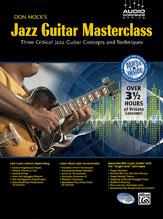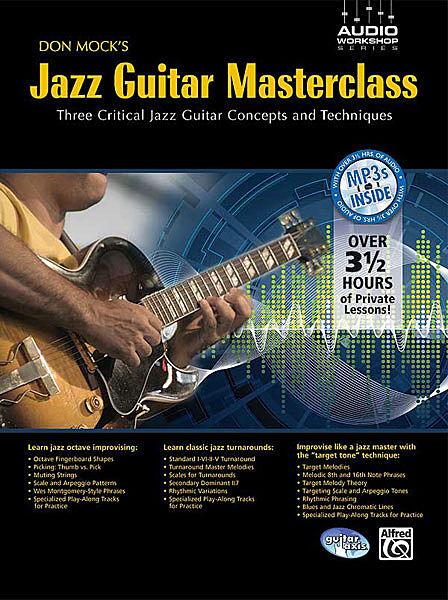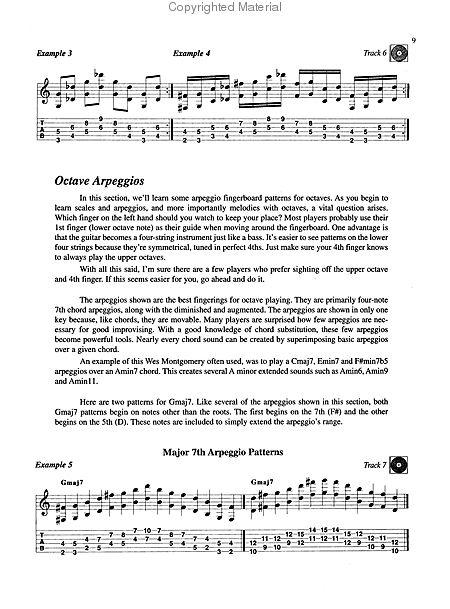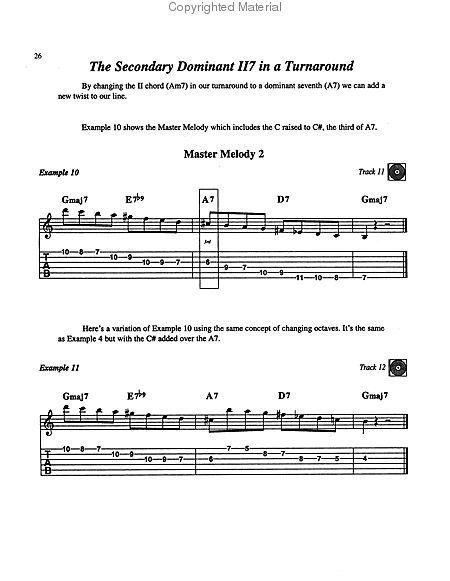MOCK'S DON JAZZ GUITAR MASTERCLASS CD TABLATURE CHITARRA LIBRO METODO SPARTITI
MOCK'S DON, JAZZ GUITAR MASTERCLASS. LIBRO CON CD E TABLATURE
LIBRO METODO DI MUSICA JAZZ CON COMPACT DISC
SPARTITI PER CHITARRA.
ACCORDI, PENTAGRAMMA E TABLATURE.
Category: Guitar Method or Supplement
Format: Book & CD
This amazing three-section set of personal lessons with jazz guitar guru Don Mock features hours of personal audio instruction, play-along tracks, and demonstrations, with a complete accompanying book of music examples, exercises, and transcriptions in notation and TAB. Section 1 covers the all-important, Wes Montgomery-inspired Octave Technique. Section 2 is devoted to the target tone concept, which simplifies the improvising process, enabling you to play sophisticated lines that resolve beautifully into the correct chord tones. Section 3 is devoted to turnarounds: short four-chord progressions often found at the end of tunes to setup and return to the beginning.
"Don, I know, mastering jazz guitar can take a lifetime, but are there a few concepts and techniques I can work on now to improve my playing?'" This is a pretty common question, and one I hear from students all the time. To many, the world of jazz guitar seems like it's made up of hundreds of difficult concepts and techniques along with a dizzying amount of complex theory. But a lot of players just want to learn a few manageable ideas to get under their fingers without being drowned in heavy concepts. I usually answer the question by reminding them that learning to play jazz can be a life-long endeavor, but it's also an ongoing "work in progress." You can't wait around practicing until you think you are good enough to playa gig. As Howard Roberts always said, "You are a guitar player from the first day you pick it up." Learn a few things and get out and play, then continue to develop your skills. The three ideas outlined in this book, octaves, turnarounds, and target tones, are important cornerstones of jazz guitar. Serious players at any level can jump into these subjects and have great results. It's important to remember that this is really an audio lesson with a companion book, not the other way around. Most of the in-depth discussion, demonstrations, and performances are on the CD; the book is for reference, showing the examples and short descriptions. And don't be surprised if, when I've finished performing some of the examples, I keep on playing to demonstrate additional ideas, or just 'cause I'm having too much fun to stop! Without a doubt, one of the single most emulated and beloved techniques in jazz guitar are octaves played in the style of the great Wes Montgomery. Virtually every jazz guitarist today uses octaves to some degree. I highly recommend to my students that they become proficient with octaves and able to play at least the melodies to tunes. It's one technique that can bring soulful fullness to melodies. This book focuses on the right-hand pick, or Wes/thumb techniques, and octave fingerboard shapes. You'll learn lots of Wes-inspired phrases as well as useful scale and arpeggio patterns. Arguably, the most powerful chord progression in jazz is the turnaround. Turnarounds are a lot more than a short group of chords found at the end of tunes. On closer examination, they are made up from smaller chord moves that are the essence of jazz and pop music, like major and minor II-V-I progressions. Numerous examples of substitution ideas, such as fiat-fives and secondary dominants, can be applied to turnarounds. Like a lot of players, I struggled with turnarounds, especially at faster tempos. My frustration led me to break down and analyze each of the four chords, and to learn some classic melodic lines for turnarounds. Then, I could at least manage improvising and comping over faster turnarounds. But when I came up with the simple idea that is outlined in this book, turnarounds quickly became my favorite type of progression. This book teaches you a simple approach to mastering turnarounds, centering on a basic "master melody" that captures the sound of each of the four chords. Then, it's simply a matter of moving the notes to different octaves to create variations of the line. All my students who apply this concept have made huge leaps in their playing of turnarounds, and e-mails from players around the world confirm they've had the same positive results. Another topic that sits at the top of my list of "must learn" concepts for jazz guitar is target tones. "Target tones" is really a cliche name for the art of using chromatics in improvising. I discovered early in my career that the chromatic scale alone was not the solution for creating melodic lines with chromatics. My search to understand it allIed to several books and recordings of everything from classical music to modern jazz. It became clear that good melodies often had mini-melodies contained within them that used the "wrong" non-scale tones to support, strengthen, and set up strong tones. I began using very basic fournote target-tone melodies within my scales and arpeggios. Immediately, I was creating lines that contained some, or even all, the "in-between" tones. But more importantly, the lines retained the sound of the chord I was soloing over. We'll go over a few easy target melodies and take aim at chord tones. It' a surprisingly simple but powerful concept that should have you playing traditional, modem, and bebop jazz chromatic melodies in a fairly short time. I hope you enjoy working on the three topics in this book. Feel free to begin with anyone of them. Be sure to listen to the CD, and take advantage of the play-along tracks.
Title MP3 File
Preface
Introduction
Tuning Notes
Fingerboard Octave Shapes
Muting Strings
Picking: Thumb vs. Pick
Octave Exercises
Octave Arpeggios
Octave Scales
Melodic Lines Using Octaves
"Blues Axis" Jazz Blues Tune
Conclusion
"Blues Axis" Play-Along Track
Am7 Groove Play-Along Track
II-V-I in C Play-Along Track
F7 Groove Play-Along Track
Minor II-V-I in Am Play-Along Track
Title MP3 File
Turnarounds
Introduction
Tuning Notes
The Standard I-VI-II-VTurnaround
Turnaround Master Melody
The Secondary Dominant in a Turnaround
Scales for Turnarounds
Turnarounds in Blues
8th-Note Turnaround Etude
Rhythmic Variations
Rhythmic Turnaround Etude 2
Flat Fifth Substitution
I-VI7-II-V in G Play-Along Track
I-VI7-117-Vin Bb,Play-Along Track
Jazz Blues in C Play-Along Track
I-VI7-II-V in G Latin Play-Along Track
Title MP3
Target Tones
Introduction
Tuning Notes
Target Melodies
Arpeggio Fingerings
Melodic 8th-Note Phrases Using Target Melodies
Targeting with 16th Notes
Target Melody Theory
Targeting Scale Tones
Rhythmic Phrasing
Blues and Jazz Chromatic Lines
”Jazz Blues Solo Etude"
C7 Groove Play-Along
Cm7 Groove Play-Along
Cmaj7 Groove Play-Along
II-V-Iin C Play-Along Track
II-V-Iin E Minor Play-Along Track
Jazz Blues in Bb,Play-Along Track
Conclusion
About the Author
Don Mock is one of America's most respected guitar educators and players. Growing up in the





